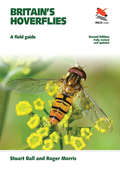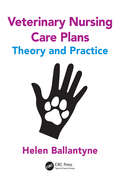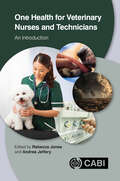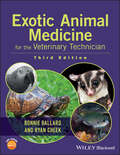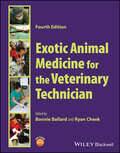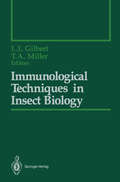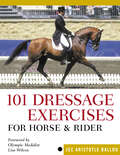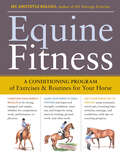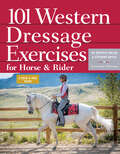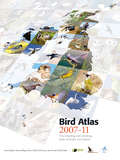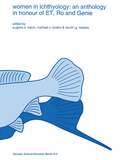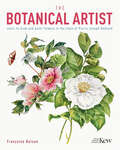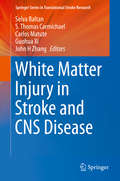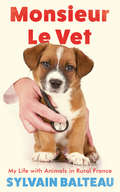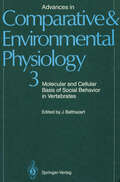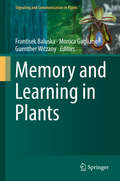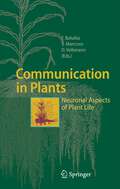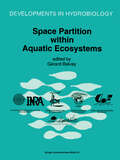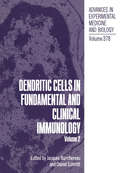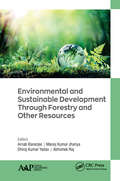- Table View
- List View
Britain's Hoverflies: A Field Guide, Revised and Updated Second Edition (PDF)
by Stuart Ball Roger MorrisBritain's Hoverflies is a beautifully illustrated photographic field guide to the hoverflies of Britain, focusing on the species that can be most readily identified. It is the perfect companion for wildlife enthusiasts, professional ecologists and anyone else with an interest in this fascinating group of insects, and is designed to appeal to beginners and experts alike.Accessible, authoritative and easy to use, this book contains hundreds of remarkable photographs of the various life stages of those species that can be identified by eye or with a magnifying glass, with coverage of at least one representative from each of the British genera. It also features an essential guide to the hoverfly tribes. Detailed species accounts summarize the species' status, highlight the key identification features, provide notes on behaviour and habitat requirements and include flight-period charts and up-to-date distribution maps. Sections on hoverfly biology, where and when to look for hoverflies, legislation and conservation, photographing hoverflies, recording hoverflies and gardening for hoverflies are also included.This fully revised and updated second edition:Features more than 650 stunning colour photographsProvides detailed information for the 167 species that can be most readily identified, including at least one species from each of the 68 genera recorded in BritainIncludes a complete list of the 283 hoverfly species recorded in Britain to date, with an indication of how difficult each is to identify
Veterinary Nursing Care Plans: Theory and Practice
by Helen BallantyneKey features The first veterinary textbook dedicated to nursing care plans Covers the theory and practice of nursing care planning, examining and critiquing the topic in depth Provides basic definitions and explanations for those unfamiliar with nursing care plans Draws comparisons and contrasts between the veterinary and human nursing roles and contexts This book offers a broad overview of the theory and practice of care planning in veterinary nursing, answering three key questions: What are nursing care plans? Why should nursing care plans be used in practice? How should nursing care plans be used in practice? It provides basic definitions and explanations which will be useful to those unfamiliar with nursing care plans. For those veterinary nurses and technicians who are using nursing care plans, the content stimulates debate and discussion, by covering some of the philosophical and theoretical aspects of nursing and drawing comparisons and contrasts between the veterinary and human nursing roles and contexts. There is a pressing need for veterinary nurses to establish themselves as professionals and develop their unique role within the veterinary care team. Nursing care plans are a core tool to support that development. It is hoped that veterinary nurses may borrow tools from the pages of this book or use it as a resource design their unique care plans: either way, this practical guide will support the application of care planning, no matter the species of the animal kingdom for whom you are caring.
Veterinary Nursing Care Plans: Theory and Practice
by Helen BallantyneKey features The first veterinary textbook dedicated to nursing care plans Covers the theory and practice of nursing care planning, examining and critiquing the topic in depth Provides basic definitions and explanations for those unfamiliar with nursing care plans Draws comparisons and contrasts between the veterinary and human nursing roles and contexts This book offers a broad overview of the theory and practice of care planning in veterinary nursing, answering three key questions: What are nursing care plans? Why should nursing care plans be used in practice? How should nursing care plans be used in practice? It provides basic definitions and explanations which will be useful to those unfamiliar with nursing care plans. For those veterinary nurses and technicians who are using nursing care plans, the content stimulates debate and discussion, by covering some of the philosophical and theoretical aspects of nursing and drawing comparisons and contrasts between the veterinary and human nursing roles and contexts. There is a pressing need for veterinary nurses to establish themselves as professionals and develop their unique role within the veterinary care team. Nursing care plans are a core tool to support that development. It is hoped that veterinary nurses may borrow tools from the pages of this book or use it as a resource design their unique care plans: either way, this practical guide will support the application of care planning, no matter the species of the animal kingdom for whom you are caring.
One Health for Veterinary Nurses and Technicians: An Introduction
by Helen Ballantyne Emi Barker Paula Boyden Hayley Burdge Kirsty Cavill Marta Costa Carla Finzel Joanna Hockenhull Nicola Lakeman Robyn Lowe Ellie WestThe One Health concept recognizes that the health of humans, animals and the environment are interlinked, and that maintaining optimal health for all is dependent on a collaborative and multidisciplinary approach at a local, national and global level. This book provides information and guidance for veterinary nurses in understanding both the scope of this concept and their role within it. Beginning with an overview of the global issues faced, One Health for Veterinary Nurses and Technicians focuses on providing an insight into how One Health can be applied within a veterinary practice and in the local community. Translating this important concept and making it relevant for veterinary nurses and their clients, this book: - Covers both communicable and non-communicable disease, as well as public health, climate change, sustainability and the importance of the human-animal bond. - Includes case studies to help to translate theory into practice. - Provides questions to help promote discussion and implement change. Reviewing the interrelations between humans, animals and their environment, this book is an approachable and useable introduction to One Health and is suitable for veterinary nurses and students in the clinical and non-clinical environment One Health for Veterinary Nurses and Technicians has been written by contributors based within the United Kingdom. However, the content is applicable to those working internationally within a veterinary environment and will also be of interest to other allied healthcare professionals.
Exotic Animal Medicine for the Veterinary Technician
by Bonnie Ballard Ryan CheekNow in its third edition, and for the first time in full-color, Exotic Animal Medicine for the Veterinary Technician is a comprehensive yet clear introduction to exotic animal practice for technicians in the classroom and clinic setting alike. With an emphasis on the exotic species most likely to present to a veterinary practice, coverage includes avian, reptiles, amphibians, fish, small mammals, and wildlife. Now in full color Features anatomy, restraint, common diseases to radiology, surgical assisting, and parasitology New chapter on fish medicine Companion website offering review questions and images from the text in PowerPoint
Exotic Animal Medicine for the Veterinary Technician
by Bonnie Ballard Ryan CheekNow in its third edition, and for the first time in full-color, Exotic Animal Medicine for the Veterinary Technician is a comprehensive yet clear introduction to exotic animal practice for technicians in the classroom and clinic setting alike. With an emphasis on the exotic species most likely to present to a veterinary practice, coverage includes avian, reptiles, amphibians, fish, small mammals, and wildlife. Now in full color Features anatomy, restraint, common diseases to radiology, surgical assisting, and parasitology New chapter on fish medicine Companion website offering review questions and images from the text in PowerPoint
Exotic Animal Medicine for the Veterinary Technician
by Bonnie Ballard Ryan CheekExotic Animal Medicine for the Veterinary Technician Comprehensive full color textbook on common exotic species, written specifically for vet techs in classroom or clinical settings Now in its fourth edition, Exotic Animal Medicine for the Veterinary Technician is a comprehensive yet clear introduction to exotic animal practice for veterinary technicians in the classroom and clinical settings alike. With an emphasis on the exotic species most likely to find their way to a veterinary practice, the book offers coverage of birds, reptiles, amphibians, exotic companion mammals, and wildlife. It also features discussions of anatomy, restraint, common diseases, radiology, anesthesia and analgesia, clinical skills, surgical assisting, and parasitology. This edition offers new updates throughout, including new chapters related to critical care feeding of exotic companion mammals, reptile infectious diseases, and exotic animal rehabilitation. It also provides full-color photos, including radiographs. Designed to provide technicians with all the information necessary to confidently and competently treat exotic patients, Exotic Animal Medicine for the Veterinary Technician offers easy-to-follow descriptions of common procedures and techniques. A companion website delivers review questions and images from the book in PowerPoint format. Topics covered in Exotic Animal Medicine for the Veterinary Technician include: Herpetoculture and reproduction, covering captive bred versus wild caught, quarantining, methods of sex determination, and reproductive behavior Criteria to determine water quality for fish, including pH, oxygen, temperature, chlorine and chloramine, and salinity Clinical techniques for degus, including oral (PO), subcutaneous (SC), intramuscular (IM), intraperitoneal (IP), catheter placement, and wound managementRole of the veterinary technician in wildlife rehabilitation, covering clinical protocols, intake procedures, ethical considerations, and choosing treatment routes Exotic Animal Medicine for the Veterinary Technician is an essential reference for veterinary technician students, along with veterinary technicians working in an exotic practice, or veterinary technicians who work in a small animal practice where adding exotic patients is being considered.
Exotic Animal Medicine for the Veterinary Technician
by Bonnie Ballard Ryan CheekExotic Animal Medicine for the Veterinary Technician Comprehensive full color textbook on common exotic species, written specifically for vet techs in classroom or clinical settings Now in its fourth edition, Exotic Animal Medicine for the Veterinary Technician is a comprehensive yet clear introduction to exotic animal practice for veterinary technicians in the classroom and clinical settings alike. With an emphasis on the exotic species most likely to find their way to a veterinary practice, the book offers coverage of birds, reptiles, amphibians, exotic companion mammals, and wildlife. It also features discussions of anatomy, restraint, common diseases, radiology, anesthesia and analgesia, clinical skills, surgical assisting, and parasitology. This edition offers new updates throughout, including new chapters related to critical care feeding of exotic companion mammals, reptile infectious diseases, and exotic animal rehabilitation. It also provides full-color photos, including radiographs. Designed to provide technicians with all the information necessary to confidently and competently treat exotic patients, Exotic Animal Medicine for the Veterinary Technician offers easy-to-follow descriptions of common procedures and techniques. A companion website delivers review questions and images from the book in PowerPoint format. Topics covered in Exotic Animal Medicine for the Veterinary Technician include: Herpetoculture and reproduction, covering captive bred versus wild caught, quarantining, methods of sex determination, and reproductive behavior Criteria to determine water quality for fish, including pH, oxygen, temperature, chlorine and chloramine, and salinity Clinical techniques for degus, including oral (PO), subcutaneous (SC), intramuscular (IM), intraperitoneal (IP), catheter placement, and wound managementRole of the veterinary technician in wildlife rehabilitation, covering clinical protocols, intake procedures, ethical considerations, and choosing treatment routes Exotic Animal Medicine for the Veterinary Technician is an essential reference for veterinary technician students, along with veterinary technicians working in an exotic practice, or veterinary technicians who work in a small animal practice where adding exotic patients is being considered.
Immunological Techniques in Insect Biology (Springer Series in Experimental Entomology)
by Joanne Ballarino Ad M.T. Beenakkers Lawrence I. Gilbert Walter G. Goodman Noelle A. Granger Bruce W. Hermann Rainer Keller Joseph G. Kunkel Michael Ma Rob C.H.M. Oudejans Hugo Schooneveld Thomas K.F. Schulz Klaus-Peter Sieber J. A. Veenstra Hans Voshol James T. Warren Shuenn-Jue WuInsects as a group occupy a middle ground in the biosphere between bacteria and viruses at one extreme, amphibians and mammals at the other. The size and general nature of insects present special problems to the study of ento mology. For example, many commercially available instruments are geared to measure in grams, while the forces commonly encountered in studying insects are in the milligram range. Therefore, techniques developed in the study of insects or in those fields concerned with the control of insect pests are often unique. Methods for measuring things are common to all sciences. Advances some times depend more on how something was done than on what was measured; indeed a given field often progresses from one technique to another as new methods are discovered, developed, and modified. Just as often, some of these techniques find their way into the classroom when the problems involved have been sufficiently ironed out to permit students to master the manipulations in a few laboratory periods. Many specialized techniques are confined to one specific research labora tory. Although methods may be considered commonplace where they are used, in another context even the simplest procedures may save considerable time. It is the purpose of this series (1) to report new developments in method ology, (2) to reveal sources of groups who have dealt with and solved particular entomological problems, and (3) to describe experiments which may be appli cable for use in biology laboratory courses.
101 Dressage Exercises for Horse & Rider (Read & Ride)
by Jec Aristotle BallouThis comprehensive training manual offers expert tips and practical exercises for mastering a variety of dressage techniques.
Equine Fitness: A Program of Exercises and Routines for Your Horse
by Jec Aristotle BallouGet your horse in shape and maintain his overall fitness, regardless of his age or abilities. Equine Fitness will have your horse looking and feeling his best with a series of fun exercise routines specifically designed to enhance his strength, stamina, and agility. Clear step-by-step instructions and detailed illustrations make the exercises easy to follow, and the book includes a handy set of pocket-sized cards that you can use in the ring. Jec Ballou&’s simple conditioning program promises lasting results for healthy horses and satisfied riders.
101 Western Dressage Exercises for Horse & Rider (Read & Ride)
by Jec Aristotle Ballou Stephanie BoylesThe exciting new discipline of Western Dressage allows riders of Western pleasure, work, or competitive horses to take advantage of the benefits of traditional dressage using Western tack and attire. This book, the first on the topic, has step-by-step instructions for the 101 key exercises.
Bird Atlas 2007-11: The Breeding And Wintering Birds Of Britain And Ireland
by Dawn Balmer Simon Gillings Brian Caffrey Bob Swann Iain Downie Rob FullerRecommended for viewing on a colour tablet. The Bird Atlas 2007–2011 is the definitive statement on breeding and winter bird distributions in Britain and Ireland.
Women in ichthyology: an anthology in honour of ET, Ro and Genie (Developments in Environmental Biology of Fishes #15)
by E. K. Balon Michael N. Bruton David L. G. NoakesThis special volume is dedicated to the contributions of women ichthyologists. Three colleagues were selected to represent all women ichthyologists, Ethelwynn Trewavas (ET), Rosemary Lowe-McConnell (Ro) and Eugenie Clark (Genie). All have had distinguished professional careers and have contributed in their own ways to their science. The career of each is highlighted by a personal interview with one of the editors of the volume, a bibliography of their lifetime publications, and a biography of their careers. Questions of historical inequities and current controversies in the treatment of women ichthyologists by their peers are raised and addressed by the women themselves. The personal and professional influences of these three women, and other women ichthyologists, are highlighted. A survey article by Pat Brown brings a number of women ichthyologists to the attention of a broader audience, and points the way for a more comprehensive historical consideration of the accomplishments and contributions of women ichthyologists. The volume continues with 16 solicited and contributed papers. ET's studies of taxonomy and life history are echoed in papers on the taxonomy and systematics of marine angelfishes, and of freshwater bitterlings, a review of reproduction in the North Atlantic ichthyofauna, and a comparison of reproductive styles and systematics of African minnows. Ro's studies on ecology, life history and behaviour are paralleled by papers on growth and metabolism in piranha, the community structure in tide pool fishes, and the social system and reproductive patterns in groupers. Genie's pioneering work on sexual roles and sex change, and her field studies of the behaviour of marine fishes are reflected in papers on gonadal structure and environmental sex determination in brook lamprey, sexual patterns in hawkfish, reproduction and systematics in phallostethids, gonadal structure and systematics in gobiids, reproductive and predator avoidance behaviour in razorfish, early ontogeny of an African mouth brooder, and alternative life histories in killifish.
The Kew Gardens Botanical Artist: Learn to Draw and Paint Flowers in the Style of Pierre-Joseph Redouté
by Francoise BalsanCapture the enchanting beauty of the natural world with this delightful botanical drawing book, inspired by the extensive archives held at the Royal Botanical Gardens, Kew.This practical guide makes use of botanical illustrations by such masters as Pierre-Joseph Redouté, Georg Ehret and W H Fitch among many others to explore techniques and how to illustrate the various components of plants accurately.• A guide to the tools and materials you will need• Step-by-step projects based on famous artworks, plus advice on how to create your own unique illustrations• Guidance on the techniques of drawing, composition and perspective• Explanations on using different media, especially the most commonly used medium of watercolourLearn from the masters of the craft to produce delicate botanical artwork, based on the beautiful flora that grows around us.ABOUT THE SERIES: Arcturus Publishing and The Royal Botanic Gardens, Kew have collaborated to create a wonderful selection of botanical-themed art, crafts and activity books, including origami, dot-to-dots and color-by-numbers.
White Matter Injury in Stroke and CNS Disease (Springer Series in Translational Stroke Research #4)
by Selva Baltan S. Thomas Carmichael Carlos Matute Guohua Xi John H ZhangWhite matter injury can result from both ischemic and hemorrhagic stroke as well as a host of other CNS diseases and conditions such as neonatal injuries, neurodegenerative disorders including Alzheimer's disease, traumatic brain injuries, carbon monoxide poisoning, and drug or alcohol overdoses. The extent of white matter injury is extremely important to patient outcomes. Several recent technological developments including advanced neuroimaging and the breeding of new rodent models of white matter injury have provided growing insight into initial damage and repair after a stroke or other damaging event. The proposed book will be the first to provide a systematic expert summary of normal white matter morphology as well as white matter injury following stroke and other CNS injuries.
Monsieur le Vet: My Life with Animals in Rural France
by Sylvain BalteauThe hilarious, poignant and sometimes bizarre stories of an extraordinary vet in rural France Sylvain Balteau works as a village vet in the Pyrenees. Equally at home with a sick hamster as with a pregnant Charolais cow, he is permanently on call, immersed in the daily dramas of animals and their people. Since 2007 he has kept a blog, revealing the hidden side of a vet’s work and the rich variety of French rural life. As well as caring for the usual puppies and elderly cats, he tries to save a man’s pet piglet and patches up hunting dogs after the annual wild boar hunt. Then he can be found carrying a newborn calf into a remote farmhouse to warm up by the fire, or pleading with a farmer’s wife on the verge of a heart attack who insists that the vet see her sick cow first … Through his work with their animals, Sylvain gains a privileged insight into the people who live with them. In this profound and unsentimental book, he discovers that, in order to love animals, you can’t help but love people as well.
Molecular and Cellular Basis of Social Behavior in Vertebrates (Advances in Comparative and Environmental Physiology #3)
by J. Balthazart J. D. Blaustein W. R. Crowley L. C. Drickamer C. A. Dudley H. H. Feder R. L. Moss L. H. O'Connor D. H. Olster D. R. Sengelaub P. SöderstenUnderstanding the brain mechanisms which underlie behavior is one of the most challenging tasks of modern biology. The study of these mechanisms can be approached using a variety of biological systems as models, depending essentially on the type of question being asked and the technical approach which is considered. In vertebrates, the study of brain neurochemistry in relation to behavior e,xpression has made tremendous progress during the last two decades. In particular, much at tention has been devoted to the effect of steroid hormones on brain structure and activity in connection with social and mainly reproductive behavior. This book exemplifies some of the major trends in the field. I did not attempt to cover exhaustively all the work that has been done in this area but rather to present a series of selected reviews on the molec ular and cellular brain mechanisms most directly related to social behavior. This selection obviously reflects my own interests but also, I believe, highlights those areas of research in which important progress has been made in recent years. A number of brain biochemical or cellular mechanisms which could be related to behavior, but have not been formally demonstrated to be so, are consequently ignored. The focus here is on social behavior and thus steroid-dependent processes are covered in priority. This choice of course leads us to ignore major trends in brain and behavior research but this is, I hope, clearly reflected in the title of the volume.
Memory and Learning in Plants (Signaling and Communication in Plants)
by Frantisek Baluska Monica Gagliano Guenther WitzanyThis book assembles recent research on memory and learning in plants. Organisms that share a capability to store information about experiences in the past have an actively generated background resource on which they can compare and evaluate coming experiences in order to react faster or even better. This is an essential tool for all adaptation purposes. Such memory/learning skills can be found from bacteria up to fungi, animals and plants, although until recently it had been mentioned only as capabilities of higher animals. With the rise of epigenetics the context dependent marking of experiences on the genetic level is an essential perspective to understand memory and learning in organisms. Plants are highly sensitive organisms that actively compete for environmental resources. They assess their surroundings, estimate how much energy they need for particular goals, and then realize the optimum variant. They take measures to control certain environmental resources. They perceive themselves and can distinguish between ‘self’ and ‘non-self’. They process and evaluate information and then modify their behavior accordingly. The book will guide scientists in further investigations on these skills of plant behavior and on how plants mediate signaling processes between themselves and the environment in memory and learning processes.
Communication in Plants: Neuronal Aspects of Plant Life
by Frantisek Baluska Stefano Mancuso Dieter VolkmannPlant neurobiology is a newly emerging field of plant sciences. It covers signalling and communication at all levels of biological organization – from molecules up to ecological communities. In this book, plants are presented as intelligent and social organisms with complex forms of communication and information processing. Authors from diverse backgrounds such as molecular and cellular biology, electrophysiology, as well as ecology treat the most important aspects of plant communication, including the plant immune system, abilities of plants to recognize self, signal transduction, receptors, plant neurotransmitters and plant neurophysiology. Further, plants are able to recognize the identity of herbivores and organize the defence responses accordingly. The similarities in animal and plant neuronal/immune systems are discussed too. All these hidden aspects of plant life and behaviour will stimulate further intense investigations in order to understand the communicative plants in their whole complexity.
Space Partition within Aquatic Ecosystems: Proceedings of the Second International Congress of Limnology and Oceanography held in Evian, May 25–28, 1993 (Developments in Hydrobiology #104)
by Gérard BalvayProceedings of the Second International Congress of Limnology and Oceanography held in Evian, May 25--28, 1993
Dendritic Cells in Fundamental and Clinical Immunology: Volume 2 (Advances in Experimental Medicine and Biology #378)
by Jacques Banchereau Daniel SchmittThese Proceedings contain the contributions of the partIcIpants of the Third International Symposium on Dendritic Cells that was held in Annecy, France, from June 19 to June 24, 1994. This symposium represented a follow-up of the first and second international symposia that were held in Japan in 1990 and in the Netherlands in 1992. Dendritic cells are antigen-presenting cells, and are found in all tissues and organs of the body. They can be classified into: (1) interstitial dendritic cells of the heart, kidney, gut, and lung;(2) Langerhans cells in the skin and mucous membranes; (3) interdigitating dendritic cells in the thymic medulla and secondary lymphoid tissue; and (4) blood dendritic cells and lymph dendritic cells (veiled cells). Although dendritic cells in each of these compartments are all CD45+ leukocytes that arise from the bone marrow, they may exhibit differences that relate to maturation state and microenvironment. Dendritic cells are specialized antigen-presenting cells for T lymphocytes: they process and present antigens efficiently in situ, and stimulate responses from naive and memory T cells in the paracortical area of secondary lymphoid organs. Recent evidence also demonstrates their role in induction of tolerance. By contrast, the primary and secondary B-cell follicles contain follicular dendritic cells that trap and retain intact antigen as immune complexes for long periods of time. The origin of follicular dendritic cells is not clear, but most investigators believe that these cells are not leukocytes.
Existential Dogs
by Pesala BandaraFrom the depths of their existential angst, these profound pooches ask some of the most pertinent questions of their time.
Environmental and Sustainable Development Through Forestry and Other Resources
by Arnab Banerjee Manoj Kumar Jhariya Dhiraj Kumar Yadav Abhishek RajThis book looks at using forestry and several other innovative measures to facilitate environmental sustainability, covering an important selection of research that focuses on scientific applications and trends. Chapters discuss such diverse topics as using agroforestry for resource management, employing legumes in agroforestry, livestock management for climate change mitigation, introducing higher plants for air pollution mitigation in urban industrial areas, the uses and benefits of sludge, technological assessment of sewage treatment plants, and much more. This book will be a helpful and informative reference for those in the disciplines of forestry, agriculture, ecology, and environmental science and will also be a pathway to addressing new concepts for a sustainable world.
Environmental and Sustainable Development Through Forestry and Other Resources
by Arnab Banerjee Manoj Kumar Jhariya Dhiraj Kumar Yadav Abhishek RajThis book looks at using forestry and several other innovative measures to facilitate environmental sustainability, covering an important selection of research that focuses on scientific applications and trends. Chapters discuss such diverse topics as using agroforestry for resource management, employing legumes in agroforestry, livestock management for climate change mitigation, introducing higher plants for air pollution mitigation in urban industrial areas, the uses and benefits of sludge, technological assessment of sewage treatment plants, and much more. This book will be a helpful and informative reference for those in the disciplines of forestry, agriculture, ecology, and environmental science and will also be a pathway to addressing new concepts for a sustainable world.
